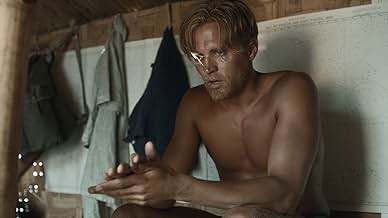Nel 1947, l'esploratore leggendario Thor Heyerdal ha attraversato il Pacifico per sette mila chilometri su una zattera, nel tentativo di dimostrare che era possibile che i sudamericani si st... Leggi tuttoNel 1947, l'esploratore leggendario Thor Heyerdal ha attraversato il Pacifico per sette mila chilometri su una zattera, nel tentativo di dimostrare che era possibile che i sudamericani si stabilissero in Polinesia in epoca precolombiana.Nel 1947, l'esploratore leggendario Thor Heyerdal ha attraversato il Pacifico per sette mila chilometri su una zattera, nel tentativo di dimostrare che era possibile che i sudamericani si stabilissero in Polinesia in epoca precolombiana.
- Candidato a 1 Oscar
- 12 vittorie e 14 candidature totali
- Thor Heyerdahl
- (as Pål Hagen)
- Herman Watzinger
- (as Anders Baasmo Christiansen)
- Thor 6 yrs.
- (as Kasper Ameberg Johnsen)
Trama
Lo sapevi?
- QuizLarge parts of the film were filmed in two versions at the same time, one in Norwegian, the other in English, in order to secure international funding. See ALTERNATE VERSIONS section for greater detail.
- BlooperThe crew were not worried about whether the ropes would hold the float together, as it is portrayed in the film. As we can see in the Kon-Tiki (1950) documentary, the balsa wood was much softer than the rope, and it was actually the rope that ate through the wood. The result was that the rope eventually was protected by the space that had been created around it.
- Citazioni
Epilogue: Bengt fell in love with Polynesia. He settled there and became a Consul General of Sweden. He died in 1997.
Epilogue: Erik built himself a sailboat, that became his home for 11 years. He worked as an artist until his death in 1972.
Epilogue: Torstein kept going on expeditions. He died in 1964 during an attempt to reach the North Pole on skis.
Epilogue: Knut resumed his career in military intelligence. He was also instrumental in the establishment of the Kon-Tiki museum. He died the Christmas of 2009.
Epilogue: Herman became the director of UN's Food and Agriculture organization. He died at Titica lake in 1986.
Epilogue: Thor wrote a book about Kon-Tiki. It was translated to over 70 languages, and sold over 50 million copies. The documentary about the expedition won an Oscar. Liv and Thor divorced after the Kon-Tiki expedition. Their boys lived with Liv, who later moved to the US where she died in 1969. Thor continued his work as an experimental archaeologist, author and explorer. He died in 2002.
- Curiosità sui creditiBefore the closing credits, short clips are shown in which original footage shot by Heyerdahl was reenacted by the "Kon-Tiki" actors: urinating overboard in the open sea, dancing with natives under palms, portraits, and the like. Along with this, brief notes concerning each crew member's path of life after the trip are given.
- Versioni alternativeIn an unusual technique, the film was shot simultaneously in both Norwegian and English, with each scene being filmed twice, first in Norwegian and then in English, with the same actors. This resulted in two versions of the film to be released, one primarily for the Norwegian domestic market, the other for an international audience. In a few cases, such as action scenes and computer-generated sequences, they used the same shot, later adding English with dubbing.
- ConnessioniFeatured in 70th Golden Globe Awards (2013)
- Colonne sonoreFlickan i Havanna
("The girl in Havana")
Lyrics by Evert Taube (as Taube) and music by Horatio R. Palmer (as Palmer)
NB: now willing to watch the original Kon-Tiki documentary film, that won Oscar in 1950, directed by Thor Heyerdahl himself during their expedition___:))))
- shahriyar-ovi
- 13 dic 2012
- Permalink
I più visti
Dettagli
- Data di uscita
- Paesi di origine
- Siti ufficiali
- Lingue
- Celebre anche come
- Hải Trình Kon-Tiki
- Luoghi delle riprese
- Nu Boyana Film Studios, Sofia, Bulgaria(New York exterior scenes)
- Aziende produttrici
- Vedi altri crediti dell’azienda su IMDbPro
Botteghino
- Budget
- 16.600.000 USD (previsto)
- Lordo Stati Uniti e Canada
- 1.517.410 USD
- Fine settimana di apertura Stati Uniti e Canada
- 22.168 USD
- 28 apr 2013
- Lordo in tutto il mondo
- 22.842.887 USD
- Tempo di esecuzione1 ora 58 minuti
- Colore
- Mix di suoni
- Proporzioni
- 2.35 : 1
Contribuisci a questa pagina

































